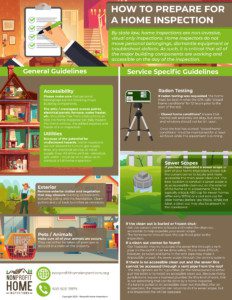Thank you for selecting Nonprofit Home Inspections for your upcoming home inspection! As a nonprofit 501(c)(3) organization, our goal is to help families and individuals make informed housing decisions by providing detailed, unbiased home inspection services. Please use the information on this page to make sure that your new home is prepared so that you can get as much benefit from your home inspection as possible.
To begin with, please note that by state law, home inspections are non-invasive, visual only inspections of a structure. Basically, that means that home inspectors are only able to inspect what they can see. As such, it’s critical to make sure that important components in a home are accessible on the day of the inspection. Please share this information with your real estate agent and the sellers in order to make the home inspection process go as smoothly as possible.
Accessibility
If the home is occupied, please ask the owner to make sure that personal belongings are not blocking major components that should be inspected. This includes anything that might be blocking access to the the attic / crawlspace, electrical panels, furnace, water heater, etc. In accordance with state law, home inspectors are not allowed to move personal belongings, so keeping these areas free from obstructions will allow the home inspector to fully inspect the home without the added expense and hassle of a re-inspection.
Utilities
Because of the potential for undisclosed hazards, home inspectors are not allowed to turn on natural gas supply lines, circuit breakers, or water supply lines. Please ask the seller to have all of the utilities turned on and functioning prior to the home inspection. This includes making sure that all pilot lights are lit and operational at the time of the inspection. Having all of the utilities on and functioning is a critical component for insuring that the devices can be properly tested and evaluated during the home inspection.
Radon Testing
If you ordered a radon test, you’ll want to make sure that the current occupants keep the home in what the EPA calls “closed home conditions” for the 12 hours prior to the start of the test. That means that normal entry and exit from the home is okay, but doors and windows should not be left wide open. Once the test has started, “closed home conditions” will need to be maintained for a minimum of 48 hours while the equipment is running. These EPA mandated protocols are necessary in order to obtain accurate results from the testing equipment. Leaving a window or door open during the test could skew the results either way and may invalidate the test completely. For more information about our radon tests, you can visit our radon testing page.
Sewer Scopes
If you have requested a sewer scope as part of your home inspection, please ask the current owner to locate and make accessible the main sewer clean out. Because this clean out can sometimes be buried or frozen shut, asking the current owners to locate and make the clean out accessible may help expedite your sewer scope. If the clean out is frozen shut, as sometimes happens with older homes, the homeowner should have the cap freed prior to the inspection.
The best location to conduct a sewer scope is at an accessible clean out on the exterior of the home or in a basement. This is typically a black ABS cap for newer homes (after early 1970s) or a cast iron cap for older homes (before late 1960s). While not ideal, a clean out may also be present in the crawlspace. If a clean out cannot be found, our inspector may try to access the sewer line through a vent pipe on the roof if it can be done safely. This is more difficult, however, as twists and turns in the vent pipe may make it impossible to push the sewer scope through the venting system.
If there is no accessible clean out and the sewer line cannot be accessed through a vent pipe from the roof, the only options are for a plumber (or the homeowner) to either pull the toilet or to install an accessible clean out. Because many jurisdictions require a licensed plumber for this kind of work, this is not something that can be done by a home inspector. If a toilet is pulled or an accessible clean out installed after an inspection, the inspector can return to do the sewer scope, but a re-inspection fee will be assessed.
If we are unable to access the sewer line through a clean out or vent pipe, we will not charge for the sewer scope and will refund all of the sewer scope fees. Having an accessible clean out ready on the day of the inspection, however, will allow your inspector to conduct the sewer scope on the day of the inspection, saving both time and money.
Additional Concerns
If you have already been to the house and have specific concerns you would like addressed, please let your inspector know as soon as possible. We will make sure to spend additional time making sure all of your questions and concerns about your new home are addressed. Please feel free to email or call your inspector in advance if you won’t be at the home on the day of the inspection. Making a list of concerns you would like addressed is a great way to put your mind at ease and to help you make better informed housing decisions.
If you have questions about other services we provide or you want to add any additional service to you appointment, feel free to contact your inspector and let them know! For a complete list of what we inspect, please review the Oregon Standards of Practice; Washington Standards of Practice; or look at our home inspections page for more information.

